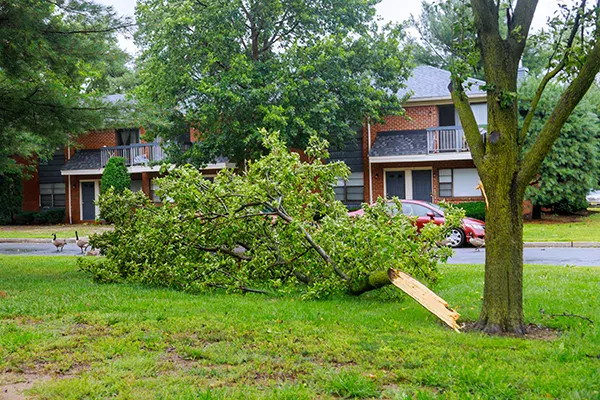When a storm hits, the aftermath can be overwhelming, especially when faced with fallen trees and debris. A tree company can assess the damage and identify any hazards, ensuring your safety.
Their experts know how to navigate tricky situations, like downed power lines. However, the help doesn’t stop there; they also offer solutions to prevent future issues.
Curious about how they can make your property safer and more resilient?
Assessing the Damage and Identifying Hazards
After a storm, a quick and careful assessment is essential for safety and proper cleanup.
Inspecting Your Property for Immediate Dangers
Start by scanning for obvious risks:
- Downed power lines.
- Fallen trees or large branches.
- Debris that could cause injury.
Checking Trees for Hidden Damage
Even healthy-looking trees may have underlying issues. Look for signs like:
- Cracks or splits in the trunk.
- Uprooted or damaged roots.
- Leaning or unstable tree structure.
Safety Precautions and Documentation
If you spot potential hazards, take these steps:
- Mark dangerous areas.
- Keep a safe distance from damaged trees.
- Take photos for insurance claims.
Calling in the Experts
Once hazards are identified, contact professionals to safely remove debris and address tree issues, ensuring the safe restoration of your property. Your well-being is the top priority!
Safe Removal of Fallen Trees and Debris
Whether doing it yourself or hiring professionals, safety is critical when removing fallen trees and debris.
Assessing Hazards Before You Start
Before beginning the removal process, check for:
- Downed power lines.
- Unstable branches or leaning trees.
- Sharp objects are hidden in the debris.
Proper Protective Gear and Techniques
Safety gear is essential for preventing injuries. Wear:
- Protective gloves and a hard hat.
- Sturdy boots and safety goggles.
- Long sleeves and pants for extra protection.
When cutting the tree, always:
- Work with the tree’s natural lean.
- Use sharp, well-maintained tools.
- Cut smaller branches first to avoid sudden movement.
Disposal and Clean-Up
Once the tree and debris are removed:
- Dispose of materials through recycling services.
- Use local waste disposal methods for larger debris.
Hiring experts ensures safe and efficient removal, protecting your property and yourself.
Preventative Measures for Future Storms
Taking proactive steps can reduce the risk of storm damage and keep your landscape safe.
Regular Tree Inspections
Inspect your trees regularly for any signs of:
- Disease or pest infestations.
- Weak or cracked branches.
- Leaning trunks or uprooted roots.
Pruning and Tree Placement
To prevent high-wind damage, consider:
- Pruning branches that could break during storms.
- Removing trees near your home or power lines.
- Ensuring trees are properly spaced for healthy growth.
Yard Maintenance and Drainage
Proper yard care helps stabilize your landscape:
- Keep your yard free of debris that could turn into projectiles.
- Mulch around trees to retain moisture and protect roots.
- Manage drainage to prevent soil erosion.
Consulting with Experts
A professional tree service can assess your landscape and provide expert recommendations to make your property more storm-resistant. This will ensure the long-term health of your trees and the safety of your home.
Taking preventative measures to protect your landscape from future storms is essential for minimizing damage and ensuring the longevity of your trees and property. You can create a resilient environment that withstands severe weather by conducting regular tree inspections, properly pruning and placing trees, maintaining your yard, and consulting with professionals.
These proactive steps safeguard your home and promote the health of your landscape, reducing the risk of costly damage and ensuring peace of mind during storm season.

